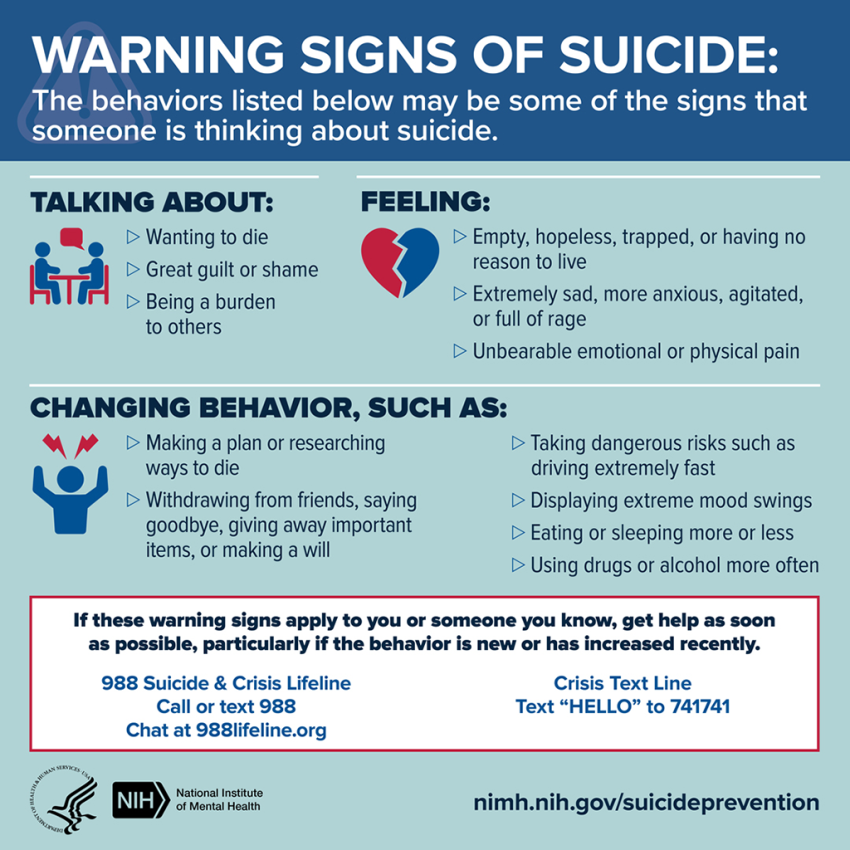By Leanna Coy, FNP-BC
This article is part of a series openly discussing the topic of suicide. The goal is to empower those struggling to seek help.
Note: This article contains information about the idea of suicide. If you or someone you know is struggling with thoughts of self-harm, help is available.
Call or text 988 or chat at 988Lifeline.org
Tillamook County Crisis Line: 1-800-962-2851 or 503-842-8201
As one of the leading causes of death in the United States, suicide is a serious public health issue. Suicide is an act of self-harm with the intent of death as a result. In 2022, suicide was the 11th leading cause of death in the country and the 2nd leading cause of death of adolescents aged 15-24 years old. The complexity of suicide relates to the mental health conditions often associated with it. Depression, bipolar disorder, substance abuse, and trauma are mental health issues frequently seen in someone considering suicide. Recognizing and treating mental illness before someone feels like they have no better options is an act of prevention.
Depressive Disorder:
Depressive disorder, usually referred to as depression, is the leading cause of suicide worldwide. Depression is a serious health condition that is more than just feeling sad or down. Severe depression can impact someone’s quality of life and their ability to do normal daily activities.
In the U.S., about 1 in 6 adults experience at least one episode of depression. In major depression, someone experiences at least two weeks of sadness or depressed mood. They also have a loss of interest or loss of enjoyment in daily activities. Symptoms include:
- Feeling sad or anxious all of the time
- Not enjoying activities that used to be fun
- Difficulty falling asleep or staying asleep
- Appetite changes with either eating more or less than usual
- Trouble concentrating or making decisions
- Loss of energy
- Thoughts of suicide or self-harm
About half of all suicides are linked to depression and other mood disorders. Treatment is key to reducing this rate, as depression often improves with treatment. Treatments range from:
- Exercise: helpful for mild to moderate symptoms.
- Psychotherapy: cognitive behavioral therapy, family therapy, and individual therapy.
- Medications: antidepressants, mood stabilizers, and antipsychotic medications may be used.
- Brain stimulation: sometimes used if psychotherapy or medications fail. Treatments include electroconvulsive therapy (ECT) or transcranial magnetic stimulation (TMS).
- Alternative treatments: acupuncture, meditation, and nutrition work well with other therapies.
Bipolar Disorder:
Bipolar disorder causes abnormal shifts in mood and energy that affect a person’s ability to think clearly. These shifts go from extreme highs, known as manic episodes, to extreme lows with depression. Signs and symptoms vary:
Manic episodes:
- Intense excitement, happiness, or euphoria
- Speaking fast or much more talkative than usual
- Excess energy and a decreased need for sleep
- An inflated sense of self-esteem
- Grandiose beliefs
- Reckless or risk-taking behavior
Depressive episodes:
- Feeling hopeless, down, or anxious
- Low self-worth or guilt
- Thoughts of death or suicide
- Fatigue or low energy
- Trouble concentrating or making decisions
The development of this disorder typically occurs in young adults by the age of 25. However, it can also occur in teenagers. The use of drugs, including marijuana, can move the onset of disease up by 6 years. In people with bipolar disorder, suicide attempts and deaths tend to align with the first episode of depression.
If left untreated, bipolar disorder will usually worsen. Treatments are similar to those for depression.
- Psychotherapy: CBT and family therapy.
- Medications: mood stabilizers, antipsychotics, and antidepressants.
- Self-management: learning to recognize early symptoms of an episode.
Substance Use Disorder:
Substance use disorders are the repeated use of alcohol and/or drugs. Often, these become addictions. Addiction is a chronic disease where people continue to use drugs or alcohol despite harmful outcomes. Repeated use of these substances alters the brain, causing cravings and behavior changes.
Substance abuse disorders are the second most common cause of death by suicide. This is true in adolescents as well as adults. Approximately 22% of deaths by suicide relate to alcohol abuse. This is followed closely by opiates. Signs and symptoms of substance abuse include:
- A high tolerance for alcohol or drugs
- Sudden change in mood or behavior
- Risk-taking behavior
- Feeling the need to use a drug or alcohol to get through the day
Among those seeking treatment, about 40% have a history of attempting suicide. Many times, treatments are complex due to other mental health issues that often exist with substance abuse.
- Detoxification: the first step in treating substance abuse. This is best done in an inpatient setting to help reduce withdrawal symptoms.
- Inpatient rehabilitation: substance abuse and mental health conditions are treated together with around-the-clock care.
- Psychotherapy: often the largest part of treatment. CBT is routinely used to help with coping mechanisms and change thinking patterns.
- Medications: medications to help ease withdrawal symptoms and mental illness.
- Supportive housing: residential treatment centers or group homes to help those trying to avoid relapse.
- Support groups: 12-step groups for people in recovery, such as Alcoholics Anonymous and Narcotics Anonymous.
Post-Traumatic Stress Disorder:
Many studies have shown a strong connection between trauma and suicide. Post-traumatic stress disorder (PTSD) occurs after someone goes through a traumatic event. Traumatic events include child abuse, sexual assault, and physical abuse. Natural disasters, a serious accident, or military combat can also trigger trauma.
PTSD does not always occur immediately after the traumatic event and can occur months or years later. PTSD is having signs and symptoms lasting more than a month and interfering with school, work, or relationships. These symptoms include:
- Feeling very vigilant, startling easily
- Experiencing flashbacks, like the event is occurring again, or having distressing memories
- Having physical pains, such as headaches or stomach aches
- Feeling detached from others, having negative self-thoughts
- Nightmares or trouble sleeping
Someone with PTSD may also have depression, anxiety, or substance abuse. Children can have PTSD and may express symptoms differently. They may have a reversal of normal childhood development for things like toilet training.
PTSD is not a curable condition. However, it can be treated.
- Psychotherapy: group therapy or cognitive processing therapy
- Medications
- Self-management: learning to self-soothe, mindfulness
- Service animals: dogs can help soothe some symptoms
When you have a concern for a mental health condition, the crucial first step is to seek care from medical professionals. Asking for help is the hardest part. Care may involve working with a primary care provider, mental health provider, or a team. They can create a comprehensive treatment plan. Early treatment can help reduce the severity of the issue and reduce the risk for someone to feel like suicide is a solution. If you or someone you know is experiencing any of the symptoms listed here, seek help. There is always hope.


